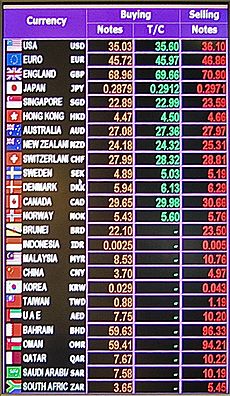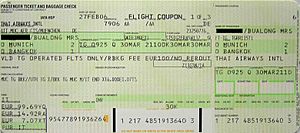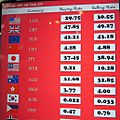ISO 4217 facts for kids


ISO 4217 is the international standard describing three-letter codes (also known as the currency code) to define the names of currencies, as established by the International Organization for Standardization (ISO). The ISO 4217 code list is the common way in banking and business, all over the world, for defining different currencies. In many countries, the codes for the more common currencies are so well-known, by the general public, that exchange rates written in newspapers or posted in banks use only those codes to define the different currencies, instead of translated currency names or currency symbols. ISO 4217 codes are used on airline tickets and international train tickets to remove any uncertainty about the price.
Contents
Code formation
The first two letters of the code are the two letters of ISO 3166-1 alpha-2 country codes (which are also used as the basis for national top-level domains on the Internet). The third letter is usually the initial of the currency itself. So Japan's currency code is JPY, "JP" for Japan and "Y" for yen. This eliminates the problem caused by the names dollar, franc and pound being used in dozens of different countries, each having significantly differing values. Also, if a currency is revalued, the currency code's last letter is changed to distinguish it from the old currency. In some cases, the third letter is the initial for "new" in that country's language, to distinguish it from an older currency that was revalued; the code sometimes outlasts the usage of the term "new" itself (for example, the code for the Mexican peso is MXN). Other changes can be seen, however; the Russian ruble, for example, changed from RUR to RUB, where the B comes from the third letter in the word "ruble".
There is also a three-digit code number assigned to each currency, in the same manner as there is also a three-digit code number assigned to each country as part of ISO 3166. This numeric code is usually the same as the ISO 3166-1 numeric code. For example, USD (United States dollar) has code 840 which is also the numeric code for the US (United States).
The standard also defines the relationship between the major currency unit and any minor currency unit. Often, the minor currency unit has a value that is 1/100 of the major unit, but 1/1000 is also common. Some currencies do not have any minor currency unit at all. In others, the major currency unit has so little value that the minor unit is no longer generally used (e.g. the Japanese sen, 1/100th of a yen). This is indicated in the standard by the currency exponent. For example, USD has exponent 2, while JPY has exponent 0. Mauritania does not use a decimal division of units, setting 1 ouguiya (UM) = 5 khoums, and Madagascar has 1 ariary = 5 iraimbilanja.
ISO 4217 includes codes not only for currencies, but also for precious metals (gold, silver, palladium and platinum; by definition expressed per one troy ounce, as compared to "1 USD") and certain other entities used in international finance, e.g. Special Drawing Rights. There are also special codes allocated for testing purposes (XTS), and to indicate no currency transactions (XXX). These codes all begin with the letter "X". The precious metals use "X" plus the metal's chemical symbol; silver, for example, is XAG. ISO 3166 never assigns country codes beginning with "X", these codes being assigned for privately customized use only (reserved, never for official codes)—for instance, the ISO 3166-based NATO country codes (STANAG 1059, 9th edition) use "X" codes for imaginary exercise countries ranging from XXB for "Brownland" to XXR for "Redland", as well as for major commands such as XXE for SHAPE or XXS for SACLANT. Consequently, ISO 4217 can use "X" codes for non-country-specific currencies without risk of clashing with future country codes.
Supranational currencies, such as the East Caribbean dollar, the CFP franc, the CFA franc BEAC and the CFA franc BCEAO are normally also represented by codes beginning with an "X". The euro is represented by the code EUR (EU is included in the ISO 3166-1 reserved codes list to represent the European Union). The predecessor to the euro, the European Currency Unit (ECU), had the code XEU.
History
In 1973, the ISO Technical Committee 68 decided to develop codes for the representation of currencies and funds for use in any application of trade, commerce or banking. At the 17th session (February 1978) of the related UN/ECE Group of Experts agreed that the three-letter alphabetic codes for International Standard ISO 4217, "Codes for the representation of currencies and funds", would be suitable for use in international trade.
Over time, new currencies are created and old currencies are discontinued. Frequently, these changes are due to new governments (through war or a new constitution), treaties between countries standardizing on a currency, or revaluation of the currency due to excessive inflation. As a result, the list of codes must be updated from time to time. The ISO 4217 maintenance agency (MA), SIX Interbank Clearing, is responsible for maintaining the list of codes.
Active codes
Official codes
The following is a list of active codes of official ISO 4217 currency names.
Unofficial codes
The following is a list of active, unofficial codes that emulate the ISO 4217 format.
| Code | Num | E | Currency | Locations using this currency | Notes |
|---|---|---|---|---|---|
| BTC | Nil | 8 | Bitcoin | Global (internet-based, anonymous electronic money) | Used on Bitcoin trading sites, and in official Bitcoin project documentation. |
Explanation of USD/USS/USN
The US dollar actually has three codes assigned: USD, USS (same day) and USN (next day). According to UN/CEFACT recommendation 9, paragraphs 8-9 ECE/TRADE/203, 1996, available online:
- 8. In applications where monetary resources associated with a currency (i.e. funds) need not be specified and where a field identifier indicating currency is used, the first two (leftmost) characters are sufficient to identify a currency–example: US for United States dollars for general, unspecified purposes where a field identifier indicating currency is present. (A field identifier can be a preprinted field heading in an aligned document or a similarly-agreed application in electronic transmission of data.)
- 9. In applications where there is a need to distinguish between different types of currencies, or where funds are required as in the banking environment, or where there is no field identifier, the third (rightmost) character of the alphabetic code is an indicator, preferably mnemonic, derived from the name of the major currency unit or fund – example: USD for general, unspecified purposes; USN for United States dollar next-day funds, and USS for funds which are immediately available for Federal Reserve transfer, withdrawal in cash or transfer in like funds (same-day funds). Since there is no need for such a distinction in international trade applications, the funds codes have not been included in the Annex to the present Recommendation.
Without currency code
A number of territories are not included in ISO 4217, because their currencies are: (a) not per se an independent currency but a variant of another currency, (b) a legal tender only issued as commemorative banknotes and/or coinage, or (c) a currency of an unrecognized or partially recognized state. These currencies are:
- Alderney pound (1:1 pegged to the pound sterling)
- Cook Islands dollar (1:1 pegged to the New Zealand dollar)
- Faroese króna (1:1 pegged to the Danish krone)
- Guernsey pound (1:1 pegged to the pound sterling)
- Isle of Man pound (1:1 pegged to the pound sterling)
- Jersey pound (1:1 pegged to the pound sterling)
- Kiribati dollar (1:1 pegged to the Australian dollar)
- Maltese scudo (1:0.24 pegged to the euro)
- Somaliland shilling (state of issue is viewed as de jure part of Somalia, exchange rate not fixed)
- Transnistrian ruble (state of issue is viewed as de jure part of Moldova)
- Tuvaluan dollar (1:1 pegged to the Australian dollar)
The following non-ISO codes are, however, sometimes used commercially:
| Guernsey pound | GGP | ||
| Jersey pound | JEP | ||
| Isle of Man pound | IMP | ||
| Somaliland shilling | SLS (rarely SLSH ) | ||
| Tuvalu dollar | TVD | ||
| Transnistrian ruble | PRB |
Obsolete currency codes
A number of currencies were official ISO 4217 currency codes and currency names until their replacement by the euro or other currencies.
Note that the currency names used below may not match the currency names used in the ISO standard itself, but the codes do match.
| Code | Num | E | Currency | From | Until | Replaced by |
|---|---|---|---|---|---|---|
| ADF | ... | 2 | Andorran franc (1:1 peg to the French franc) | ? | 1999-01-01 | EUR |
| ADP | 020 | 0 | Andorran peseta (1:1 peg to the Spanish peseta) | ? | 1999-01-01 | EUR |
| ATS | 040 | 2 | Austrian schilling | 1945 | 1999-01-01 | EUR |
| BEF | 056 | 1 | Belgian franc (currency union with LUF) | 1832 | 1999-01-01 | EUR |
| CYP | 196 | 2 | Cypriot pound | 1879 | 2008-01-01 | EUR |
| DEM | 276 | 2 | German mark | 1948 | 1999-01-01 | EUR |
| ESP | 724 | 0 | Spanish peseta | 1869 | 1999-01-01 | EUR |
| FIM | 246 | 2 | Finnish markka | 1860 | 1999-01-01 | EUR |
| FRF | 250 | 2 | French franc | 1960 | 1999-01-01 | EUR |
| GRD | 300 | 0 | Greek drachma | 1954 | 2001-01-01 | EUR |
| IEP | 372 | 2 | Irish pound (punt in Irish language) | 1938 | 1999-01-01 | EUR |
| ITL | 380 | 0 | Italian lira | 1861 | 1999-01-01 | EUR |
| LUF | 442 | 1 | Luxembourg franc (currency union with BEF) | 1944 | 1999-01-01 | EUR |
| MCF | ... | 1 | Monegasque franc (currency union with FRF) | 1960 | 1999-01-01 | EUR |
| MAF | ... | – | Moroccan franc | 1921 | 1960–1976 | MAD |
| MTL | 470 | 2 | Maltese lira | 1968 | 2008-01-01 | EUR |
| NLG | 528 | 2 | Netherlands guilder | 1810s | 1999-01-01 | EUR |
| PTE | 620 | 0 | Portuguese escudo | 1911-05-22 | 1999-01-01 | EUR |
| SIT | 705 | 1 | Slovenian tolar | 1991-10-08 | 2007-01-01 | EUR |
| SKK | 703 | 1 | Slovak koruna | 1993-02-08 | 2009-01-01 | EUR |
| SML | ... | 0 | San Marinese lira (currency union with ITL and VAL) | 1864 | 1999-01-01 | EUR |
| VAL | ... | 0 | Vatican lira (currency union with ITL and SML) | 1929 | 1999-01-01 | EUR |
| XEU | 954 | . | European Currency Unit (1 XEU = 1 EUR) | ? | 1999-01-01 | EUR |
| AFA | 004 | Afghan afghani | 1925 | 2003 | AFN | |
| AON | 024 | 0 | Angolan new kwanza | 1990 | 1995 | AOR |
| AOR | 982 | 0 | Angolan kwanza readjustado | 1995 | 1999 | AOA |
| ARL | ... | 2 | Argentine peso ley | 1970-01-01 | 1983-05-05 | ARP |
| ARP | ... | 2 | Argentine peso argentino | 1983-06-06 | 1985-06-14 | ARA |
| ARA | ... | 2 | Argentine austral | 1985-06-15 | 1991-12-31 | ARS |
| AZM | 031 | 0 | Azerbaijani manat | 1992-08-15 | 2006-01-01 | AZN |
| BDT | 1 | Bangladeshi Taka | February 1972 | Still in use | ||
| BGL | 100 | 2 | Bulgarian lev A/99 | 1962 | 1999-07-05 | BGN |
| BOP | ... | 2 | Bolivian peso | 1963-01-01 | 1987-01-01 | BOB |
| BRB | ... | 2 | Brazilian cruzeiro novo | 1967 | 1986 | BRC |
| BRC | ... | 2 | Brazilian cruzado | 1986 | 1989 | BRN |
| BRE | ... | 2 | Brazilian cruzeiro | 1990 | 1993 | BRR |
| BRN | ... | 2 | Brazilian cruzado novo | 1989-01-15 | 1990-03-15 | BRE |
| BRR | ... | 2 | Brazilian cruzeiro real | 1993-08-01 | 1994 | BRL |
| CSD | 891 | 2 | Serbian dinar | 2003-07-03 | 2006 | RSD |
| CSK | 200 | Czechoslovak koruna | ? | 1993-02-08 | CZK and SKK | |
| DDM | 278 | East German Mark of the GDR (East Germany) | 1948-06-21 | 1990-07-01 | DEM | |
| ECS | 218 | 0 | Ecuadorian sucre | ? | 2000 | USD |
| ECV | 983 | . | Ecuador Unidad de Valor Constante (funds code) (discontinued) | 1993 | 2000-01-09 | - |
| GQE | ... | Equatorial Guinean ekwele | 1975 | 1985 | XAF | |
| ESA | 996 | Spanish peseta (account A) | ? | ? | ESP | |
| ESB | 995 | Spanish peseta (account B) | ? | ? | ESP | |
| GNE | ... | Guinean syli | 1971 | 1985 | GNF | |
| GHC | 288 | 0 | Ghanaian cedi | 1967 | 2007-07-01 | GHS |
| GWP | 624 | Guinea-Bissau peso | 1975 | 1997 | XOF | |
| ILP | ... | 3, 2 | Israeli lira | 1948 | 1980 | ILR |
| ILR | ... | 2 | Israeli shekel | 1980-02-24 | 1985-12-31 | ILS |
| ISJ | ... | 0 | Icelandic old krona | ? | 1981 | ISK |
| LAJ | ... | Lao kip | ? | 1979 | LAK | |
| MGF | 450 | Malagasy franc | 1963-07-01 | 2005-01-01 | MGA | |
| MKN | ... | Old Macedonian denar A/93 | ? | 1993 | MKD | |
| MLF | ... | Mali franc | ? | 1984 | XOF | |
| MVQ | ... | Maldivian rupee | ? | 1981 | MVR | |
| MXP | ... | Mexican peso | ? | 1993 | MXN | |
| MZM | 508 | 0 | Mozambican metical | 1980 | 2006-06-30 | MZN |
| NFD | ... | 2 | Newfoundland dollar | 1865 | 1949 | CAD |
| PEH | ... | Peruvian sol | 1863 | 1985-02-01 | PEI | |
| PEI | ... | Peruvian inti | 1985-02-01 | 1991-10-01 | PEN | |
| PLZ | 616 | Polish zloty A/94 | ? | 1995 | PLN | |
| ROL | 642 | Romanian leu A/05 | ? | 2005 | RON | |
| RUR | 810 | Russian rouble A/97 | 1992 | 1997-12-31 | RUB | |
| SDD | 736 | Sudanese dinar | 1992-06-08 | 2007-01-10 | SDG | |
| SRG | 740 | Suriname guilder | ? | 2004 | SRD | |
| SUR | ... | Soviet Union rouble | 1961 | 1991 | RUR | |
| SVC | 222 | 2 | Salvadoran colón | 1892 | 2001 | USD |
| TJR | 762 | Tajikistani ruble | 1995-05-10 | 2000-10-30 | TJS | |
| TMM | 795 | 0 | Turkmenistani manat | 1993-11-01 | 2008-12-31 | TMT |
| TRL | 792 | 0 | Turkish lira A/05 | ? | 2005 | TRY |
| UAK | 804 | Ukrainian karbovanets | ? | 1996-09-02 | UAH | |
| UGS | ... | Ugandan shilling A/87 | ? | 1987 | UGX | |
| UYN | ... | Uruguay old peso | ? | 1993-03-01 | UYU | |
| VEB | 862 | 2 | Venezuelan bolívar | ? | 2008-01-01 | VEF |
| XFO | ... | Gold franc (special settlement currency) | ? | 2003 | XDR | |
| YDD | 720 | South Yemeni dinar | ? | 1996-06-11 | YER | |
| YUD | ... | 2 | Yugoslav dinar | 1966-01-01 | 1989-12-31 | YUN |
| YUN | ... | 2 | Yugoslav dinar | 1990-01-01 | 1992-06-30 | YUR |
| YUR | ... | 2 | Yugoslav dinar | 1992-07-01 | 1993-09-30 | YUO |
| YUO | ... | 2 | Yugoslav dinar | 1993-10-01 | 1993-12-31 | YUG |
| YUG | ... | 2 | Yugoslav dinar | 1994-01-01 | 1994-01-23 | YUM |
| YUM | 891 | 2 | Yugoslav dinar | 1994-01-24 | 2003-07-02 | CSD |
| ZAL | 991 | . | South African financial rand (funds code) (discontinued) | 1985-09-01 | 1995-03-13 | - |
| ZRN | 180 | 2 | Zaïrean new zaïre | 1993 | 1997 | CDF |
| ZRZ | ... | 3 | Zaïrean zaïre | 1967 | 1993 | ZRN |
| ZWC | ... | 2 | Rhodesian dollar | 1970-02-17 | 1980 | ZWD |
| ZWD | 716 | 2 | Zimbabwean dollar A/06 | 1980-04-18 | 2006-07-31 | ZWN |
| ZWN | 942 | 2 | Zimbabwean dollar A/08 | 2006-08-01 | 2008-07-31 | ZWR |
| ZWR | 935 | 2 | Zimbabwean dollar A/09 | 2008-08-01 | 2009-02-02 | ZWL |
Images for kids
See also
 In Spanish: ISO 4217 para niños
In Spanish: ISO 4217 para niños


